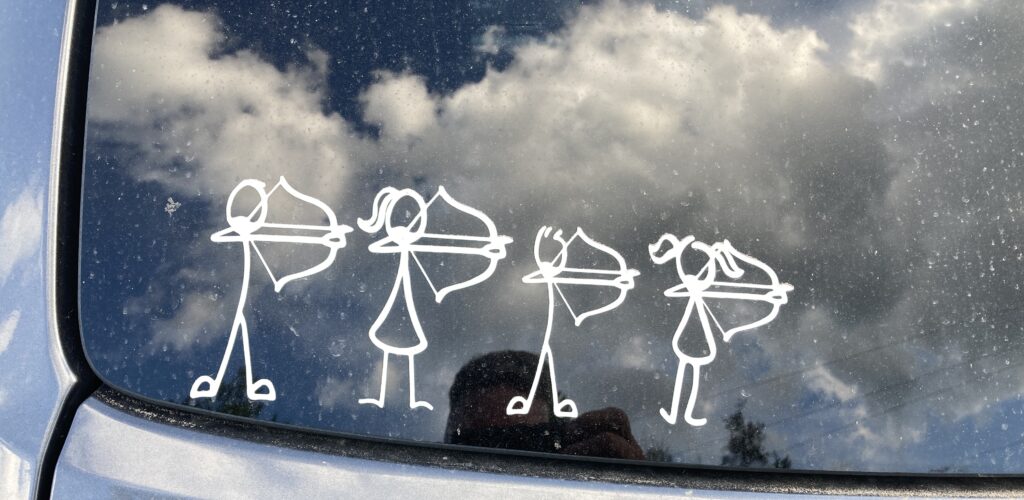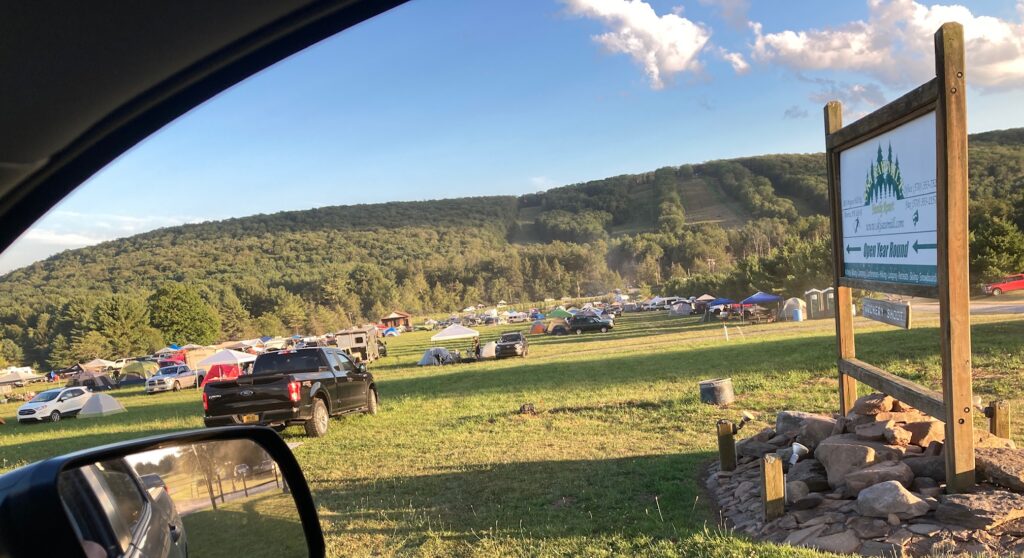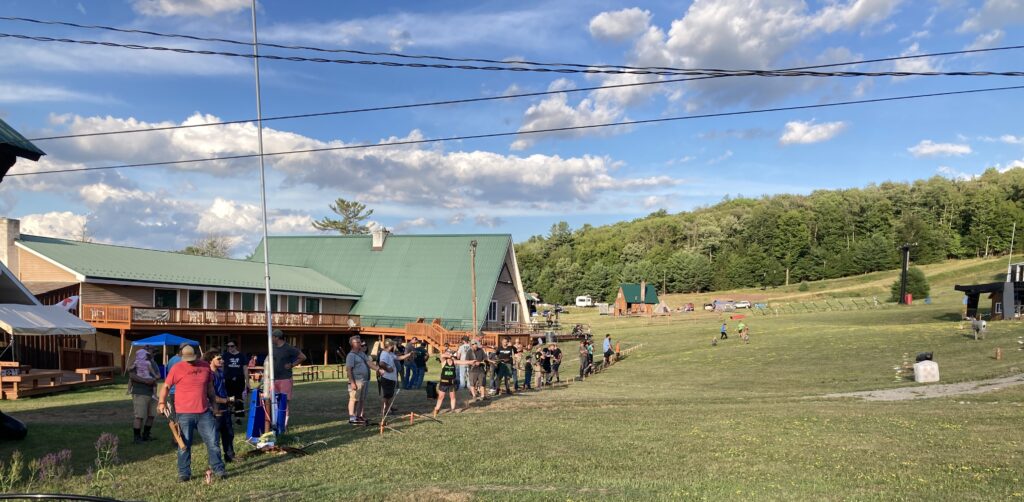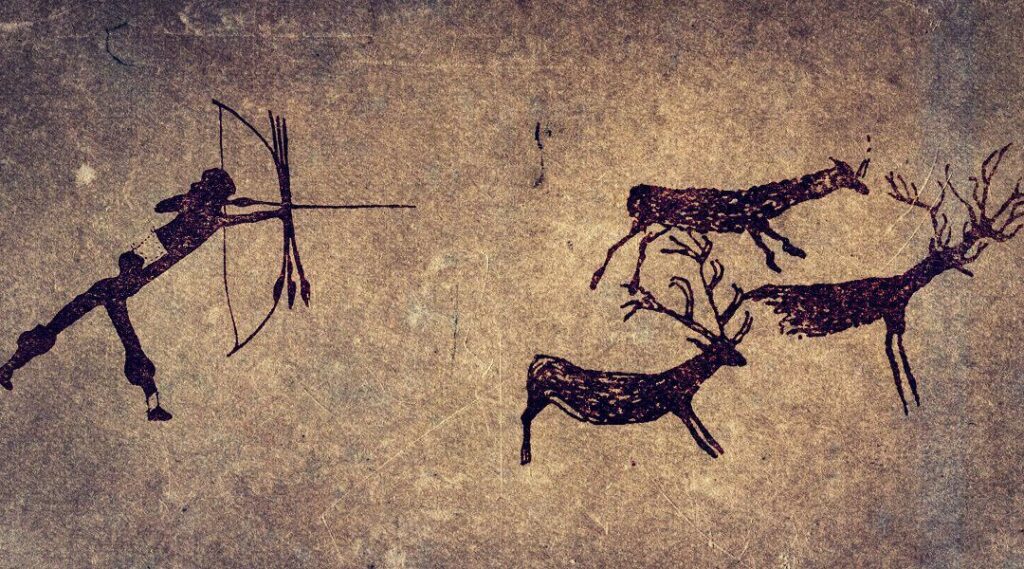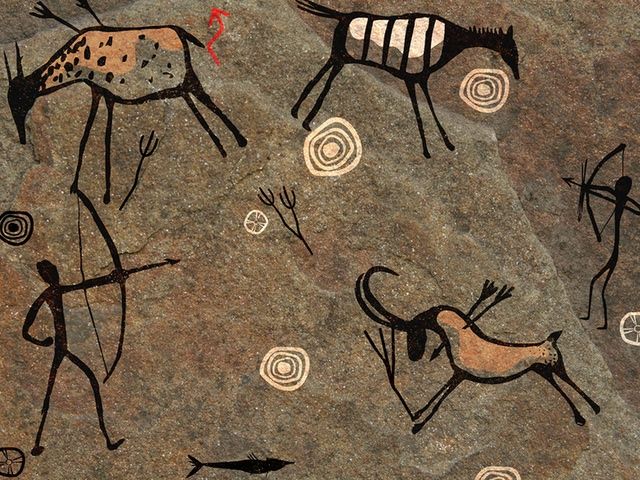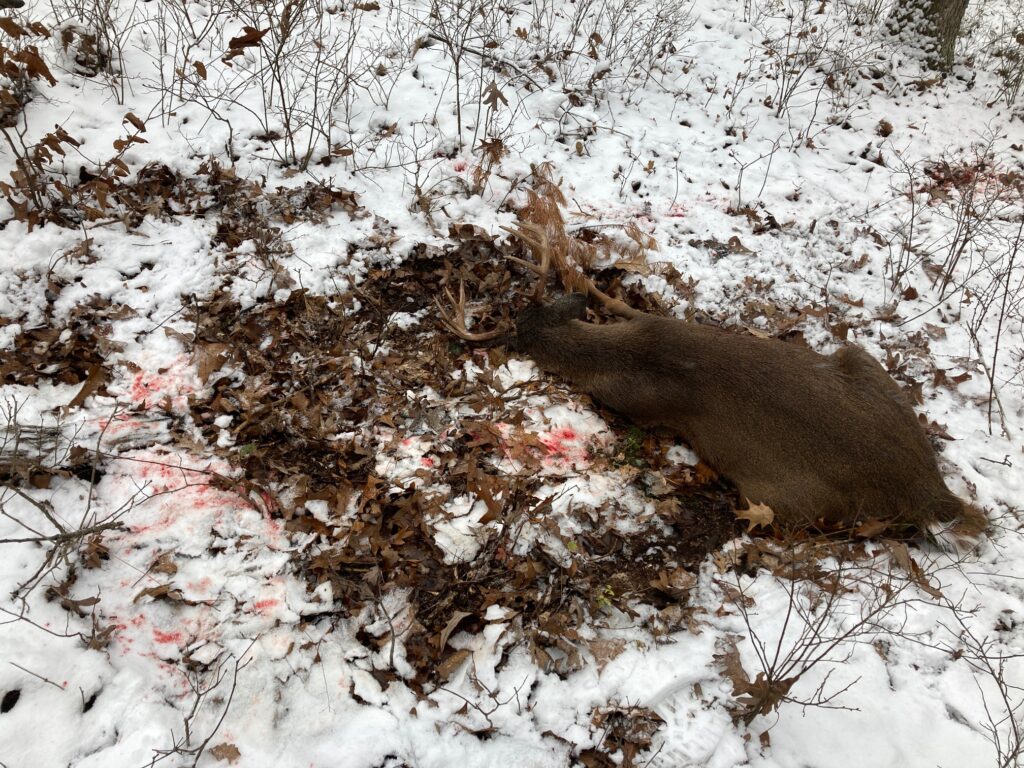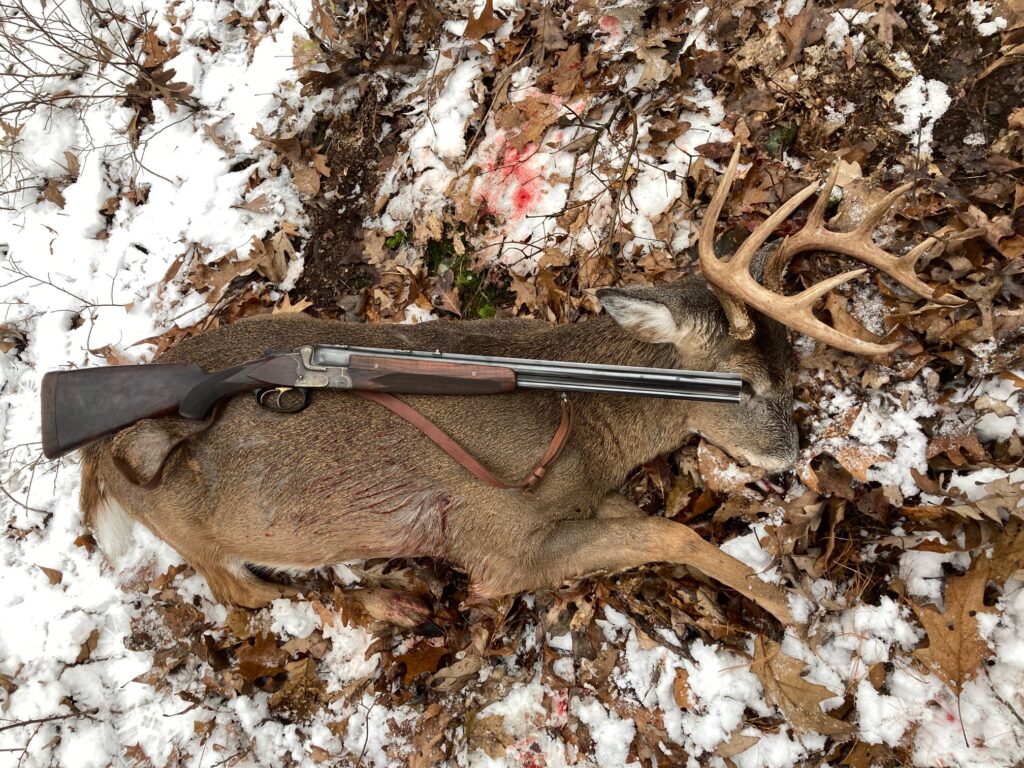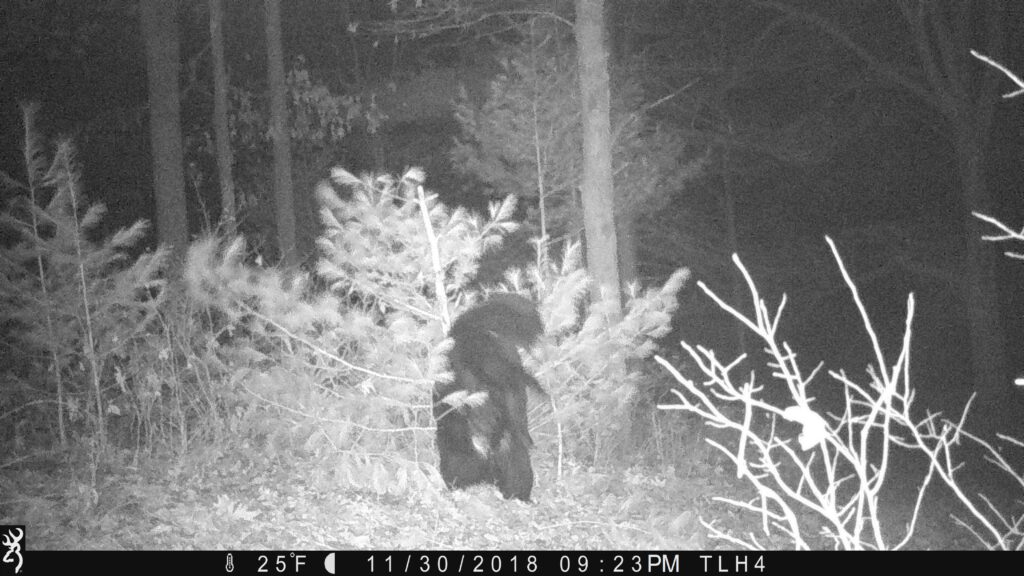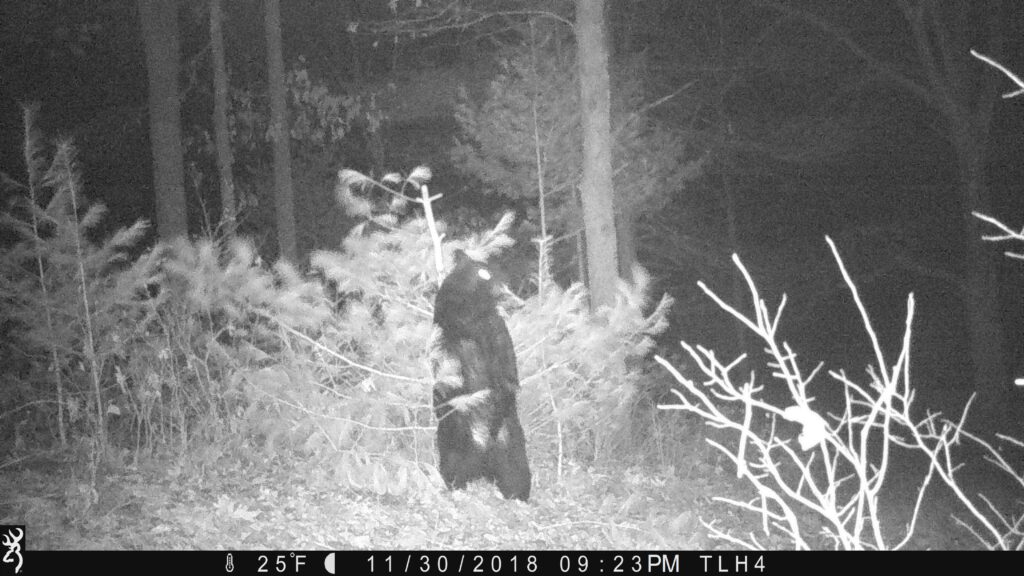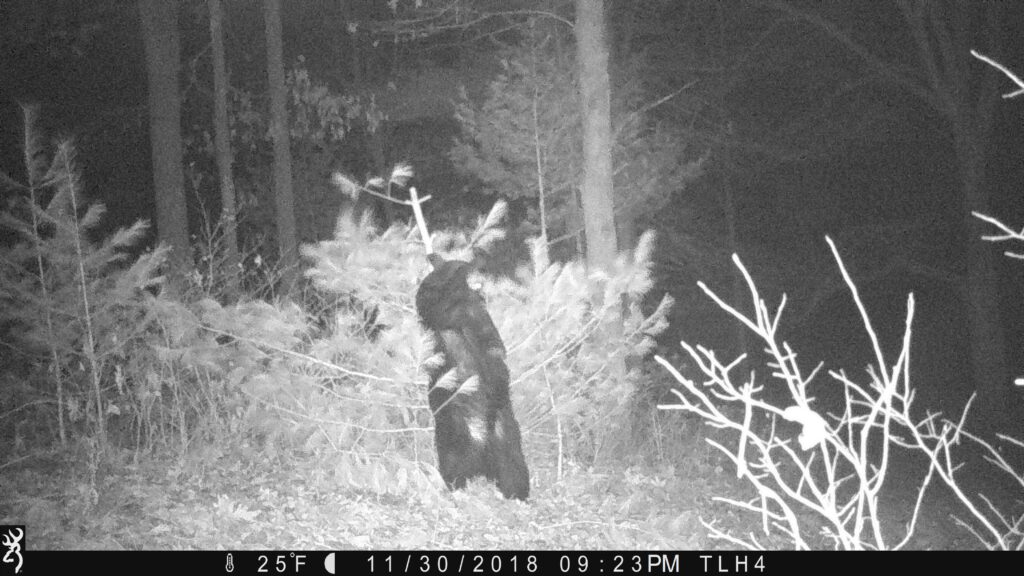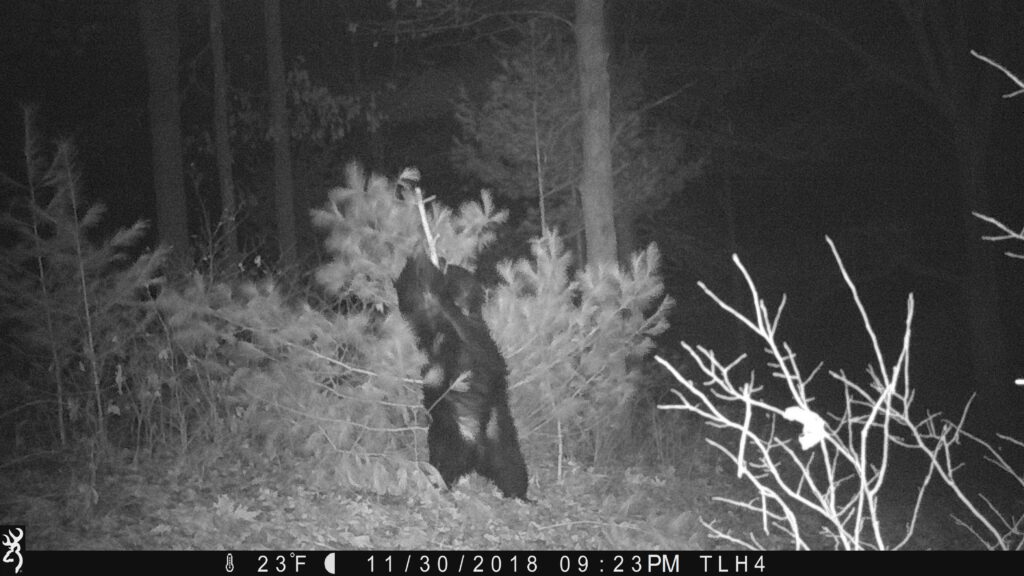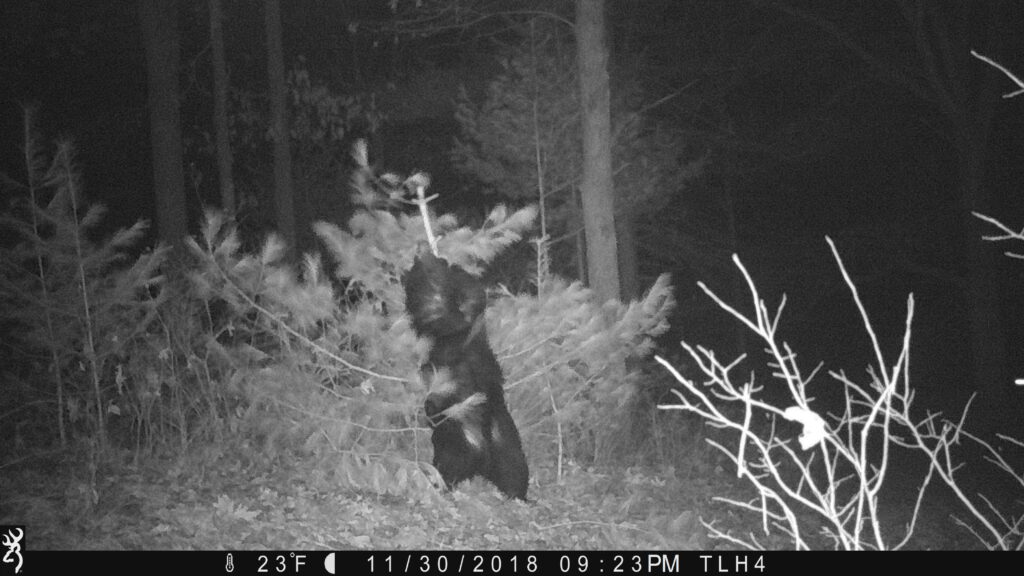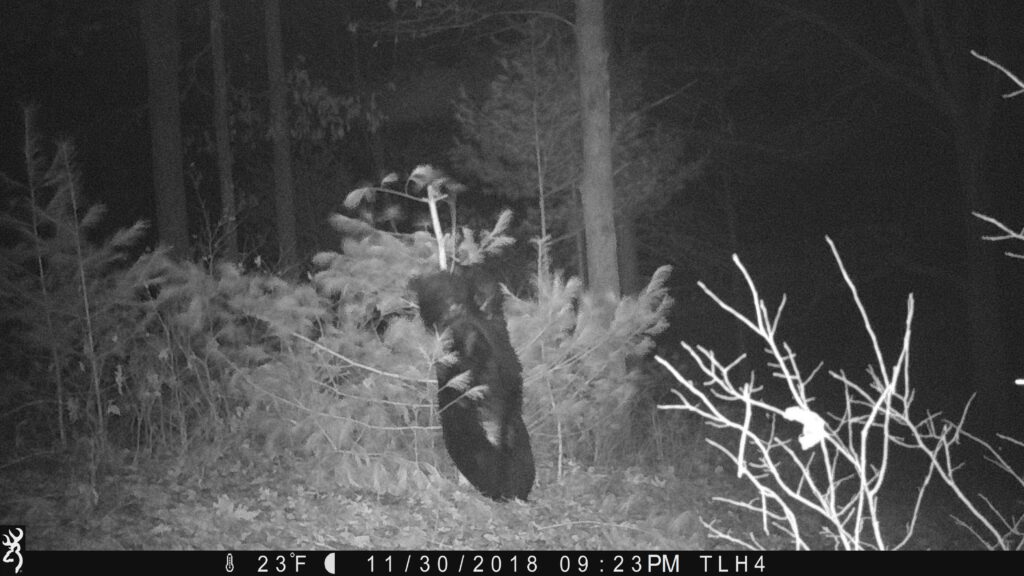Posts Tagged → hunt
We interrupt our regular political bickering to bring you Deer Season
People who don’t hunt may think they have some serious political differences. Well, they have not yet gotten involved in the Pennsylvania deer hunting wars, where fifteen years ago PA Game Commission board members and senior staff believed they had to wear bullet proof vests to public policy gatherings, such was the intensity of hate and vitriol…over deer.
With deer archery season ending Sunday night (our first Sunday hunt of the year) and deer rifle season just two weeks away, what better time to interrupt all the political acrimony from Tuesday’s mid-term election and introduce people to some real genuine debate. Yep. About deer.
Last week PA Governor Tom Wolf signed into law a change to the annual antlerless deer (doe) tag purchase system that only took twenty five years of bipartisan effort to achieve. All too well are Pennsylvania hunters familiar with the gigantic pink envelopes that screamed out to anti hunting Postal Service employees “Throw me away, throw me away!”
The gigantic pink envelope doe tag application system had been in place since the 1970s, and the system that was implemented in the 1970s was only a slight modification of the doe tag allocation process from the 1940s. That is how freaking backwards one major aspect of PA’s deer management program has been…hunters living in 2022, but operating in 1945.
And yeah, aspects of 1945 were great improvements over the sinking cultural ship nonsense we have going on today, but the gigantic pink envelope doe tag application lottery was not one of them. In the era of the Internet and email and texting, the now discarded doe tag system relied upon an unreliable Postal Service, two licked stamps, a check, multiple folds in the gigantic pink envelope, exactly the correctly checked boxes, and hoping your application made it in on time, or No Doe Tag For You!
And for most deer hunters, having a doe tag is a really big deal, because the harvest rate on does is about forty or fifty percent, while the success rates on wily bucks is about fifteen percent. Having a doe tag meant a much higher likelihood of getting fresh and healthy venison for your family and personal enjoyment. And not having the doe tag, because of some ridiculous minor bureaucratic rule or unchecked box in the application, was a big deflation for many a hunter.
Now we are going to have an online doe tag lottery and application process. No more photos of gigantic pink envelopes stacked up in Postal Service back rooms, waiting to be sent in weeks after their best-by date.
What is the doe hunt all about? It is about managing Pennsylvania’s over-abundant deer herd so that the non-hunting public doesn’t start to think that we hunters can’t get the job done right. It is a big and important job. In Europe, if wild game populations get too big and begin causing agricultural damage and car crashes, the local hunters actually get fined for it. Here in PA we have an enormous impact from too many deer, and a gigantic whiny peanut gallery that wants even more deer. Much more than the landscape can feed or than the public can afford to pay for.
Deer population management is done by the PA Game Commission. PGC uses hunting harvest numbers, statistical models, and input from individual hunters, hunting groups, landowners, farmers, “birds ‘n bunnies” environmental groups, and timber companies. One of the loudest voices is from hunters who want to see more deer, but who don’t care about the cost that those deer impose on other people. It is a tough job, requiring PGC to balance a lot of competing interests.
I am always surprised to hear hunters complain about PGC’s deer management, because invariably these critics really don’t know the actual mechanics of how it is done. Nor do they bother to take the time to learn the mechanics. Nor do they take the time to go on a local State Game Lands tour, to understand about deer impacts on the landscape. Instead, these hunters behave like communists and demand that everyone else provide year-’round room and board to the overabundant deer that they want to experience for just a few days a year. As much as I love our hunters, I am getting more and more cranky with them in my old age. Guys, please get educated about this subject, or just leave the adults alone.
This summer my wife and I drove out to Colorado and back. We passed endless deer roadkills on I-76 on the way out, but from the Ohio border westward, we saw just two dead deer on the side of the road. One in Iowa and one in Nebraska. On our way back to Pennsylvania, we saw no roadkills anywhere until we crossed into PA on I-80. Literally within the first mile of entering PA we began counting the freshly dead deer, and we continued that counting all the way home to central PA.
This Fall I hunted elk in northern Centre County and western Clinton County, and we saw TONS of deer every single day. This northcentral PA area is supposed to have no deer since 2001, if the official lazy stumpsitter hunter assessment is to be believed. The fact is, both PGC and DCNR have done fabulous jobs of clearcutting large blocks of forest, which has resulted in perfect habitat for deer and a bunch of other important animals. A hunter simply must get up off his butt and go do the Elmer Fudd hunting thing, nose into the wind. If this is too difficult for you, then deer hunting is not your thing.
I have hit several deer on the road in the past two years, each one doing expensive damage to my vehicles. My friend Mark just totaled his expensive sports car on the PA Turnpike 110 miles west of Harrisburg, because a deer walked out in front of his 70 MPH missile. He texted that the tow truck driver said that his was the sixth deer collision the tow truck operator had to address in 30 hours. That is just one tow truck in one small area, and so we know (and see with our eyes) that the deer collision problem is enormous, and expensive, and unnecessary,
Hopefully with the elimination of the gigantic pink envelope the PGC will also change the way it issues doe tags and the number it issues. I hunt all over PA and my opinion is, you can’t really issue too many doe tags. Especially in the southeast part of the state. WMUs 5B, 5C, and 5D should have unlimited doe tags. Apply for one and get one up until the end of the season.
There are so many deer everywhere, and all of them are causing enormous damage and highway carnage. This is presently a hunting problem to be solved by hunters, and unless PA hunters want to go the way of Washington State, where hunting as a wildlife management tool is being taken off the table, they had better step up and do the job and fix the problem.
Sayonara, Gigantic Pink Envelope! We won’t miss ya! And now that that problem is fixed, let the deer wars bickering begin about doe tags all over again. One camp living in 1945, the rest living in 2025. Can’t wait…..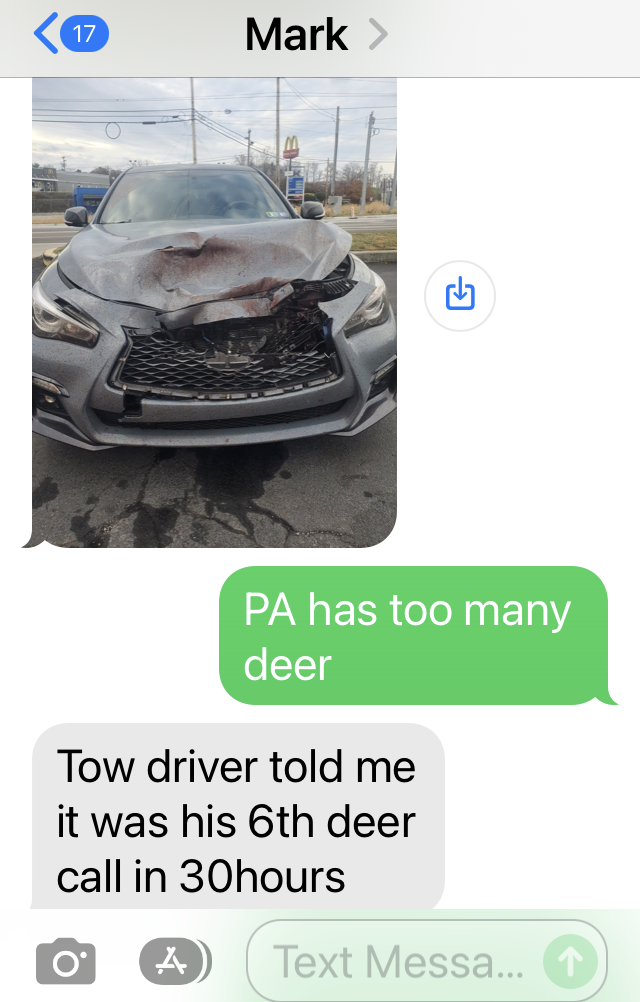
Eastern Traditional Archery Rendezvous 2022
Jack Keith brought me to my first Eastern Traditional Archery Rendezvous in 2000, back when it was held at Denton Hill State Park in Potter County, Pennsylvania. Jack was the new and the first president of the Pennsylvania Parks and Forest Foundation, fresh from the Army National Guard out at Fort Indiantown Gap. I helped Jack get the brand new PPFF office set up, and he treated me to a trip up north that changed my life.
At the 2000 ETAR, Jack introduced me to Mike Fedora, who was one of the individual forces behind resurrecting traditional archery in America. Many people will argue that traditional archery never went away, but after Mike Fedora started making modern stick bows in reflex-deflex (a high performance combination of long bow and recurve), a lot more bow makers joined in. Fedora made me a bow to my body’s specifications that fit me like a glove, and that I still use. It is a 52 Lb @ 28″ reflex-deflex that is an extension of my soul. Having hunted small game and deer as a kid with cheap fiberglass bows and also a basic Fred Bear bow, I was excited to get my very first custom bow.
Fast forward 22 years and ETAR is now held at Ski Sawmill on the Tioga County-Lycoming County line, on the beautiful Oregon Hill plateau near Pine Creek Valley.
Two years ago my son purchased his second custom bow at ETAR (his first was when he was eight years old). It is by David Darling at The Kalamazoo Bow Works, a 46# @ 25″ draw beautiful statement about how far bow making has come in the past twenty years. Better epoxies, better bow presses, better materials, and constant refinements of the reflex-deflex style now yield bows that are as light as a feather, but which pack enough punch to take any North American animal.
Last week I got to participate in one of traditional bow hunter Fred Asbell’s classes. Although Mister Asbell is 82 years old, he is still out shooting a traditional bow and helping people figure out everything from their grip to their release to how and when to draw on a deer that is just five yards away. While you can watch online videos of sheep hunters killing huge wilderness rams at 450 yards with ultra magnum rifles topped with the Hubble Space Scope all day long, what you won’t see much of are the rare Fred Asbells, taking huge trophy rams with a recurve at 40 yards after a day-long crawl. Fred Asbell is a legend for a reason, and we are so fortunate to have him helping us today.
The two things that Mister Asbell said to me that I took away were I must “allow” my brain to follow its natural inclination when shooting instinctively. This allowance is a natural flow that is easily interrupted by overthinking a shot, aiming a shot, etc. Second, he said that in order to ingrain that natural pattern of allowance so that it becomes truly instinctive, I must both “practice daily,” and make sure that I am “practicing smart.” Meaning, concentrate on each and every arrow being released. He said that as soon as I find myself mindlessly flinging arrows, it is time to stop, because it will simply reinforce bad habits, instead of honing good habits and improving skill.
Advice like this sounds basic, but that’s the genius of someone like Mister Asbell: He breaks down all the artificial complications into just a few words and physical activities that can be easily achieved, if the shooter but focuses each and every arrow released off the bow rest.
Lots of Amish are beginning to camp out at ETAR, and I am hearing more and more from hunting outfitters from Quebec and Newfoundland to Alaska how their Amish and Mennonite clients are showing up with traditional bows and muzzleloaders, and yet outshooting the other hunter clients who are each carrying the super ultra magnums topped with a Hubble Space Scope. Just sit on any of the many ETAR ranges’ firing lines and watch tiny little barefoot Amish kids step up and let fly, and you will understand how they do it, why they grow up to be such amazing archers. No training wheels, no special stabilizers or sights on their bows…
One of the things I always enjoy about ETAR is that I can strike up a conversation with literally anyone, and have a long conversation about American politics and culture, or a long joke-telling session, and always end with a friendly “Real nice to meet ya!”
My own desire is to see Clay Hayes and Ryan Gill set up separate and joint workshops on primitive archery (not just traditional, but a stick and a sinew string with flint-tipped arrows). Plenty of ETAR participants are bringing nice Osage orange split bow blanks, so there is a demand for this kind of truly rustic archery.
This year’s attendance was over 4,000 on Friday, so overall it was probably over 10,000, guessing, when it wrapped up lunch time on Sunday. Major brands like KUIU were represented. To my eye this year’s ETAR was a grand success. If you have a desire to get back to basic archery, so you can have more fun both shooting and hunting, then I recommend visiting ETAR next year. Bring a trailer or a tent, and be prepared to camp out among a lot of other really neat, positive, happy people. When we drove off site, we were watching people begin to potluck Friday dinner. People probably save up their best pronghorn, elk, bison, and venison cuts to cook and share at ETAR. Talk about good people and good times…
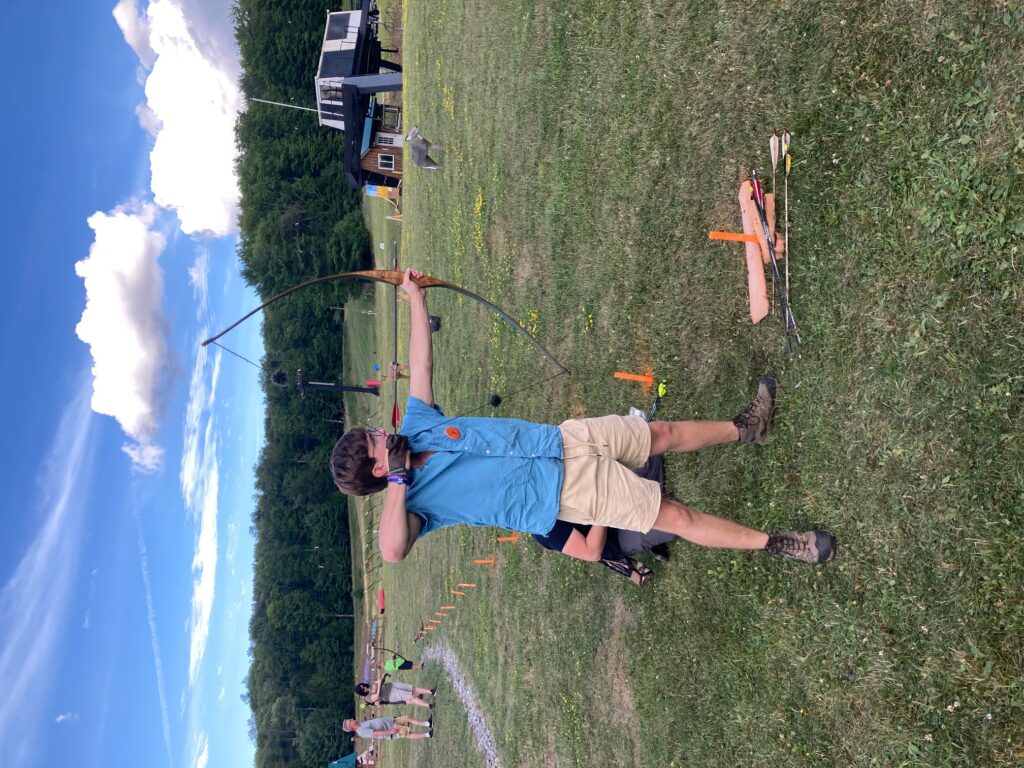
A dedicated young man practicing with his new bow at ETAR 2022. His shooting form was praised by an old timer as “a stone cold killer.”
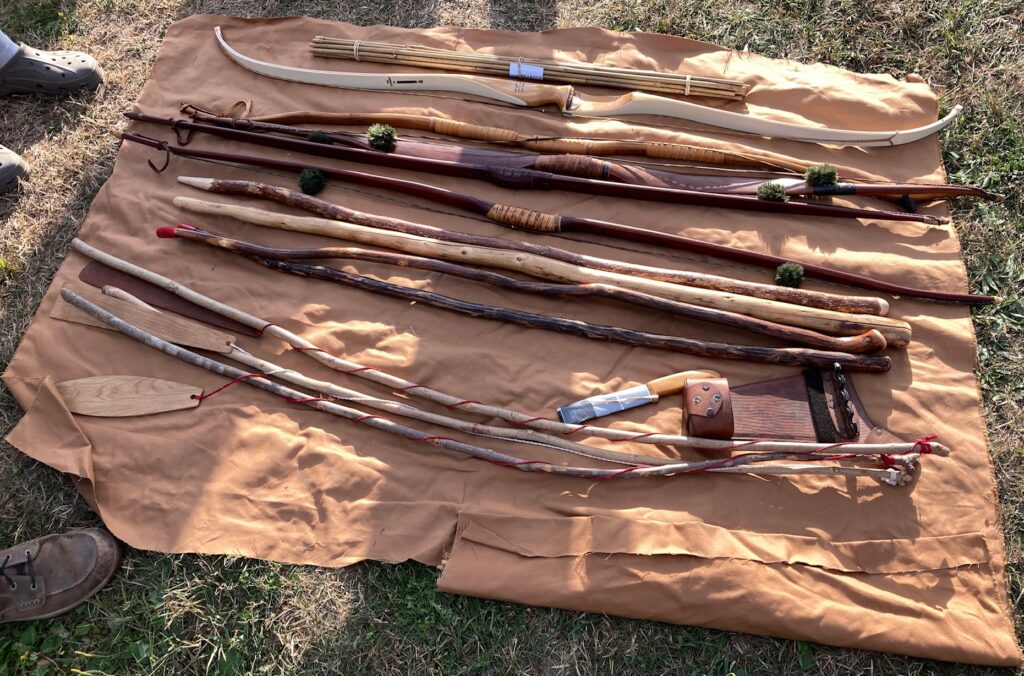
The swap-meet is probably the most exciting opportunity to acquire raw materials, rare items, hand made archery stuff. When it first started the place was a zoo! Probably a thousand people excitedly milling about looking at all kinds of neat items laid out on blankets

The all-American man who got me back into traditional archery. Jack made me a set of cedar arrows twenty years ago that now sit as a remembrance to this amazing human being. Dear Jack, it is good you are not here to see what has happened to your beloved West Point, your beloved US Army, or your beloved America…but don’t worry, we will fix it
Please do not pet the landowner
A few weeks ago, my wife looked up, startled. Her eyes were fixated on something over my right shoulder, and then she said “There are some men on the porch. Were you expecting visitors today?”
Uh, no, I was not only not expecting any visitors that day, I was not expecting any visitors the entire weekend. Because I was alone with my wife and relishing our rare private time together in a quiet out of the way dead-end location.
Just as I stood up from the table and turned towards the front door, an older guy with a greying stubble knocked. Another guy in his fifties was standing near him, and both were dressed in casual-to-ratty-on-the-crick clothes. I did not recognize either of them, and reflexively felt for the grip of “Biden’s Lung Buster” at my side.
Opening the door and stepping outside, I buried my rumbling fury under a big steaming pile of humor: “Hi boys! You can put the free beer here on the porch and help yourselves to load of firewood on the way out.”
With big smile, of course.
The two men were nice enough, and laughed at my joke. They explained that they had been fishing down in the creek that morning and had heard a gobbler up above them on the mountain. And that had set them in motion trying to figure out a way to get to the gobbler, to hunt it, without trespassing on what they acknowledged is very clearly posted private land all around the gobbler.
After what they said was a lot of driving around and walking and consulting maps, they determined the best way to attain their goal was to drive up the posted and very long gravel driveway to the remote home nestled way the hell back in the woods, and then to knock on the door and ask permission to both hunt the gobbler at present time and in the future cross over our property to access state forest land farther up the mountain.
“You two bastards are lucky as hell I didn’t come busting out here buck naked with an AR to run you off, because the angry naked old man thing is about a hundred times worse than the gun,” I half joked.
The two interlopers chuckled at the joke, and started getting the hint. After all, the land AND the driveway are all posted for a reason. Privacy is a valuable and rare thing, and because many Americans today seem to have been raised without any manners or a sense of self-preservation, big yellow posted signs, buckets of purple paint, and gates are now a necessity to preserve what shreds of privacy people have remaining to them.
But these guys had purposefully ignored all of the legal and physical barriers designed to keep them out of my private life.
“Yeah, I have had that same bird in gun range twice this week, including earlier this morning, and I have decided to let him live, because he is a rare survivor up here,” I explained, truthfully.
Wild turkeys used to be plentiful in Northcentral PA, and for the past fifteen years they are now as rare as hen’s teeth, due to a combination of factors like mature forests and craploads of nest-raiding predators.
“Well, could we at least cross over your land to get to the state land?” the second guy asked, having taken a step backwards off the porch and onto the steps.
To which I replied with bare naked contempt: “Why would we let strangers walk through our best hunting ground so they can go hunt where they want? We leave that area as a sanctuary so we can hunt it carefully, and having people walk through it would just ruin it for our hunting, to say nothing of our privacy up here. And it is remote and quiet up here…right? Guys, there are over two million acres of public land within an hour’s drive of here, and you guys need to be here, right here, on us?”
The second guy looked chagrined, and I felt only the slightest twinge of regret for having spoken so plainly.
“Well, we thought it wouldn’t harm anything if we asked,” said the first guy, who was studying his feet.
And that’s the thing. The signs around the property and at the gate on the private driveway do not say “Hunting By Written Permission Only” or anything similar about asking for permission to hunt on the land.
Rather, the myriad signs and purple paint say keep out, stay out, do not enter, do not trespass, no access, no anything, private land don’t even ask. And frankly, every square inch of private land in the valley (which is about 93% public land) is heavily posted and jealously guarded, so physically asking anyone for permission to hunt is both a fool’s errand and a deliberate theft of someone’s valuable privacy. It is an invasion of someone’s sanctuary.
Folks, don’t try to pet the landowner. He is likely to bite, because he was sleeping comfortably in his quiet little corner when you came up to him, woke him up, and acted like petting him was the best thing he could have ever expected or wanted. When in fact all he wants is to be left alone in his quiet little corner. He never asked you to pet him and doesn’t want you to pet him. He doesn’t want to see or hear you, either.
For some odd reason, a lot of people across America believe that public land sucks to hunt on, and that private land is where all the wild game is holed up. Nothing is farther from the truth than this incorrect notion; almost all of the trophy deer and bears I have killed were on public land. If getting to a piece of public land is difficult, then you should do everything legal you can to get there, because in my extensive experience, hardly anyone else will be hunting that area. But one thing you cannot do is badger the adjoining private landowner. Sending a letter explaining yourself, or placing a friendly phone call, is the only correct way to ask permission.
What is hunting?
With hunting seasons drawing to a close here in Pennsylvania, it is worth the time to revisit an old question, which is What is hunting?
We ask because, without question, non-hunters overwhelmingly support hunting that is fair chase and purposeful. That is, hunters who are seen by the public to be respectful of our prey are recognized as a positive force, and worthy of continuing their pastime.
Every scientific opinion survey asking Americans their opinion about this subject for the past several decades has yielded the same result: Hunters who actually hunt get respect and support from non-hunters. On the other hand, people who are perceived by the general public to be casually killing animals just for pleasure or for “trophies” usually do not garner much support.
While there is a lot for us to talk about with even just the survey question itself, like how America has become so urbanized and thus our people so distant from the natural resources and processes that feed and clothe us and wipe our butts (toilet paper from trees harvested in forests) etc, this particular question, and its answer, is most important because hunters are a minority of a minority in America.
Positive public opinion about hunters and hunting is necessary to the continuation of regulated hunting as we know it and as it has been practiced for the past 100 years.
Given that American hunters are lamentably awash in a sea of soulless plastic and stainless steel rifles these days, whereupon the Hubble Telescope-equivalent scope is mounted, many owners of these contraptions are regularly and quite naturally tempted to attempt military-grade long distance sniper assassinations of far-off big game animals.
Though fleet of foot, strong of heart, and equipped with majestically sensitive noses, ears, and eyes, these animals cannot compete with humans who are so far removed from the natural zone of awareness these animals’ senses otherwise provide them. This begs the question of whether or not long-long-distance shots at these clueless animals are actual fair chase hunting, or are they incautious and disrespectful maltreatment of animals we otherwise admire.
Honestly, this stark question brings to my mind the images of charismatic megafauna hand-painted on cave walls by our spear-wielding ancestors: Rhinos, gigantic cave bears, massive aurochs, lions, zebras and wild horses, bison, etc. dangerous animals all, taken at great personal risk and at bad breath distance, contrasted with today’s ego-driven high-fence “trophies” mounted on manicured man cave walls around America, animals snuffed out without a chance at fight or flight. The cave paintings were the Sistine Chapel experience for paleolithic humans, and today’s manicured egocentric faux trophy rooms are very sorry substitutes. Authentic versus fake, they couldn’t be more different from one another.
So, a bear or deer taken with a bow, a crossbow, a spear, an atlatl, a blowgun, a shotgun, a flintlock or percussion muzzleloader, or a modern muzzleloader or rifle with open sights seems like a pretty natural example of fair chase. The 400-yard Hubble Telescope plus “500 Magnum Killem” caliber assassination of the unknowing and unsuspecting beast is just that, an assassination. Is there anything fair or chase about it?
Just as political America now requires a return to our simple and beautiful founding principles, so will our hunters benefit from returning to mastering the basics of early American woodcraft, the ability to sneakily slither and glide into the wind across a landscape to get within the animal’s sensory zone and make an honest and competitive kill. This kind of field craft is the essence of fair chase.
Artificial reliance by hunters on high tech is embarrassing, to tell you the truth of how I feel. Repent and return to the basics, brothers and sisters! Our fellow Americans who do not hunt will not only support us, they will admire us, and as a result of their admiration our outdoor lifestyle will have a much greater chance of surviving beyond the high tech culture that is otherwise crushing everything natural and alive in its unwholesome path.
Anatomy of a deer season
It doesn’t matter if you archery hunt for deer religiously, from October 1 to mid-November; the archery season is always over way too fast.
It doesn’t matter if you archery hunt a bit for bear and deer, hunt the week of early muzzleloader for bear and doe, do some small game hunting, have the men up to camp for bear season for four days, and then hunt every day of deer rifle season. The ending is always the same: It ended way too fast. We wait all year for this time, and before you can blink an eye, it is over.
For many hunters, this time is about being afield, hunting. The occasional actual killing part is a welcome indication that the hunting part was done well. Proof that the time spent outside was not wasted.
Oh, we still have some late deer season remaining, which is the late archery and flintlock hunt. But by now, deer everywhere in Pennsylvania are on high alert. A twig falling out of a tree and rustling a leaf on the ground will send a nearby deer herd into panicked stampede into the next county. So getting deeply enough into the sensory zone of these intelligent animals to take one with a bow or a flintlock at this stage takes real skill, not just the usual luck.
Although I will hunt the flintlock deer season, because I have some DMAP tags left, looking back even now with a sense of longing has me thinking about the anatomy of a good deer season. Some take-aways:
- Eat good food. Whether it is home-made jerky and dried fruit we make ourselves for our own time afield, or it is the extra thick gourmet steaks we bring to hunting camp, eat the best quality food you can afford. Hunting alone or with friends and family is a celebration, so eat like you are celebrating. And because Man does not live on bread alone, make sure your drinks are of a commensurate high quality.
- Practice, practice, practice with your gun. Archery hunters practice non-stop, but for some reasons many gun hunters leave it to one box of ammo and the days right before the season to “practice” shooting. Well do I recall sharing a range with a guy from Lancaster County at the bench next to me. Friendly enough, he enthusiastically, if spastically, launched his one box of “extra” shells down range as rapid fire as a bolt action can fire. I had offered him the use of my spotting scope and Caldwell shooting sled, and he declined. He did end up relying on my spotting and calling his hurried shots, however, because he didn’t quite have his scope figured out. The old random “spray n’ pray” is the approach he packed up and drove off to hunting camp with. Do any of us think he hit what he shot at?
- Bring your best jokes, naughty or practical. Hunting camp is fun, and each of us must contribute to that festive atmosphere. Many years ago, I bent down to inspect a strange looking object hiding under the cabin’s kitchen counter. And just as quickly I jumped back and screamed like a little girl when the damned thing took off running. That it was merely a muskrat pelt attached to a fishing line being pulled by Bob and followed by uproarious laughter at my expense just made my revenge all the sweeter. As for naughty jokes and rhymes, the list is endless. Look them up and bring half a dozen. Maybe I am lowbrow, or maybe I have low expectations, but it sure seems that everyone present laughs at these men-only jokes.
- Get out into position early, like at least an hour before first light, and when you move play the wind (nose into the wind), go quietly and slowly, and carry your gun port-arms and not across your back. If you can get out into position at 4:30am, even better. Just bring a blanket and some Zippo hand warmers.
- Food sources matter for deer and bear, too. We humans are not the only ones who both enjoy and need food. In a year of abundant acorns, a stand of sweet tasting white oaks will draw more deer and bear, and you can sit down wind of that stand of trees. In a year of scarce acorns, like this year, any tree that had a decent crop will still draw animals pawing in the leaves for whatever may be left in early December. By this mid-November, almost all of the already scarce acorns were eaten up, and both bear and deer seemed to be moving widely across the landscape in search of any food. It makes for tough hunting, and so we have to team up with buddies and other camps to work together to scoop up what animals are out there. Be flexible and think outside the box of a permanent stand.
- Speak animal language. Last year I grunted in an Adirondacks wilderness buck after busting him out of his bed. He was a territorial and aggressive SOB. But the conditions were all wrong for playing around, and although his body was visible, I could not shoot through the beech brush to get him. This year I returned for Round Two with the same animal, which had probably never seen a human being, and after two days of tentative efforts, Day Three resulted in the furious huge buck storming right in to my position with leaves, twigs, snot and mouth foam flying. I shot him in the neck at five yards, five miles from my truck. Lot of work, totally worth it for that DIY hunt of a lifetime. My position was carefully chosen for what he could see or smell under a certain wind direction. I waited until it was all just right, and let fly. His response was immediate.
- Take pictures, send them in emails. While journaling is not dead, most people today do not write in a personal or camp journal. Instead, we take photos and email them around. The recipients always appreciate them. Especially when ten or twenty years has suddenly passed, our knees don’t seem capable of all those steep climbs and hard sidehilling drives any longer, and a lot of our best times at hunting camp are sitting around with dear friends and reminiscing together. So don’t forget to take pictures and share them.
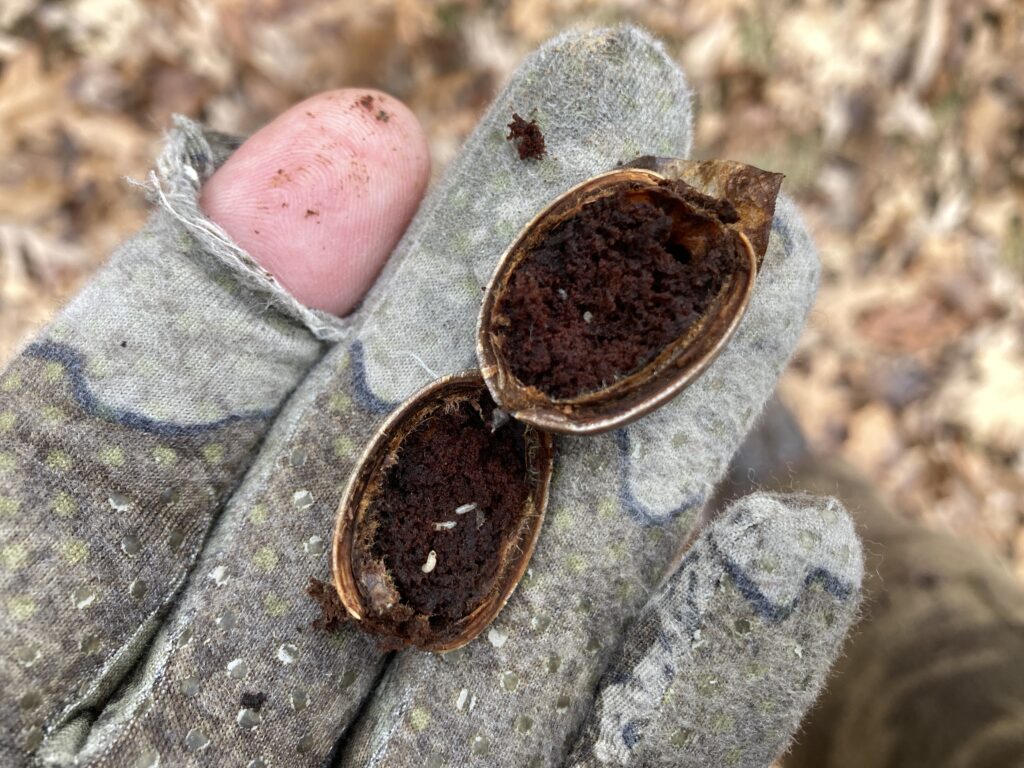
Northern PA’s acorn crop largely failed in 2021, possibly due to a late frost that killed the acorn flowers. Acorns remaining on the ground looked OK from the outside, but were all rotten like this on the inside. Wildlife is hungry and moving widely to locate food.
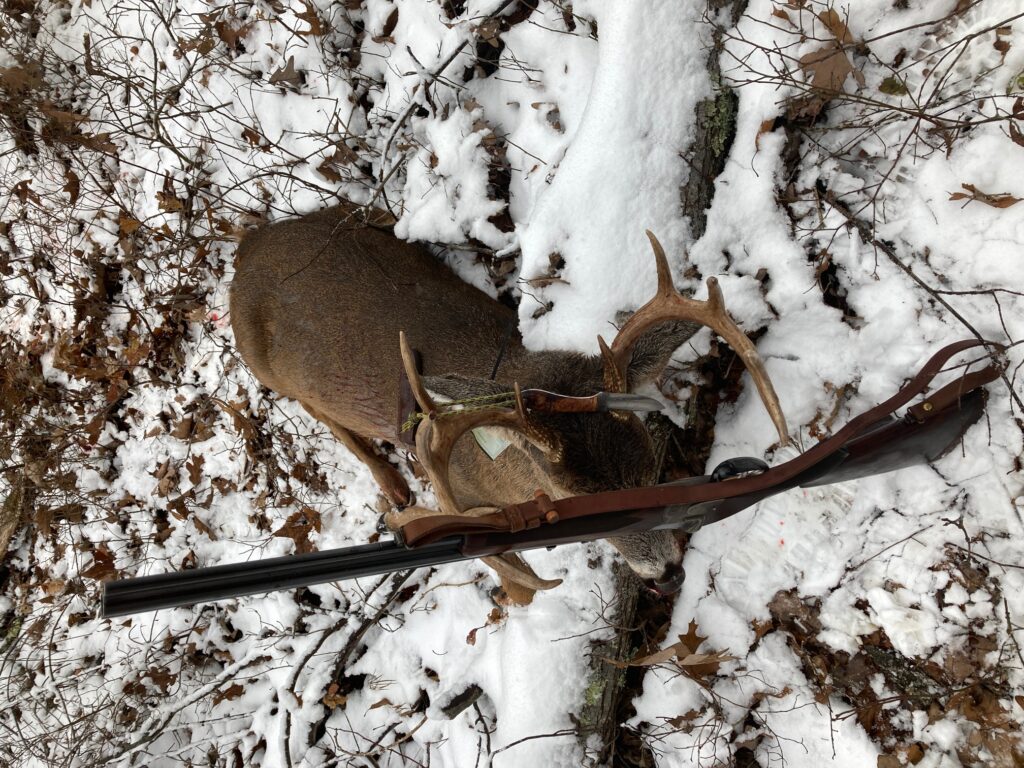
My “Freedom Buck,” killed on Sunday November 28th at 7:45am, on private property in PA. The ban on Sunday hunting is an attack on freedom, and so I named this Sunday morning buck after my declaration of freedom.
The deer that got away, but shouldn’t have
Below is the buck after the second bullet, at about 140 yards, the hole of which is visible behind his shoulder; a classic behind-the-shoulder double lung/ top of heart hit. Usually it’s immediately fatal. Usually the animal is knocked down by the impact. But not that day. He absorbed the second soft point without moving, just standing there broadside, as if I had completely missed him. Even after he dropped he had a lot of life and fight left, as can be seen in his death spiral in the snow.
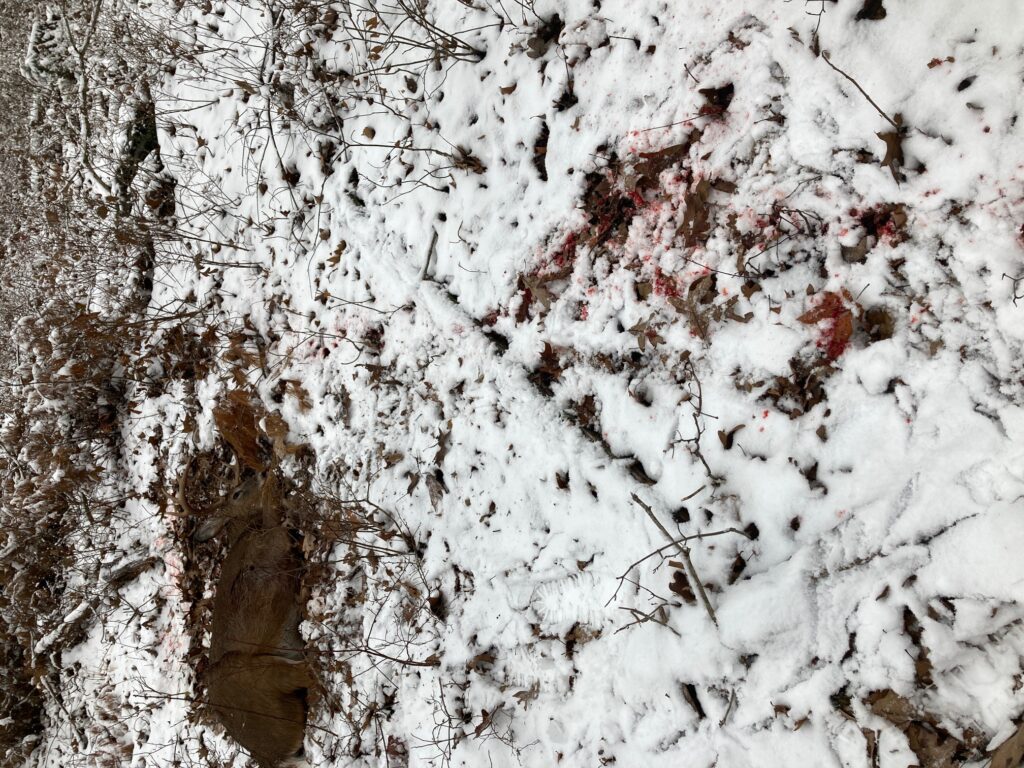
My challenge was that I did not see him fall, which happened while I was fumbling with my binoculars. Because I do not often use a rifle scope, I do not maintain a magnified field of view after my shot. Going back and forth between open sights and binoculars is my process.
As an aside, you may wonder why I use open sights, or you may be one of those people who deride open sights. Shooting instinctively with open sights is how I grew up and how I learned to hunt. Unlike a scope, open sights can take a lot more abuse in the field before they go out of whack. Unlike a scope, they cannot possibly lose their “zero” after spending eleven months in a closet. Open sights are absolutely reliable, and perfectly effective. Recall that American infantry are qualified on open sights out to 600 yards (or meters), so it is not like these things are relics from the past. Open sights are the best option, provided they are installed correctly and checked annually.
My preference for open sights is about more than performance, however. It has to do with how I like to hunt: On foot, getting close to the animal, within its sensory zone, and trying to kill it on its own terms, up close. This is a true contest of skill, not an assassination. And I hardly think an open-sighted center fire rifle is a disadvantage; it is a huge advantage over a spear or a bow. Scoped rifles are just that much more of an advantage.
So, I did not see the buck fall, and he fell into a small swale where I could not see him. Not wanting to stink up the woods and ruin further hunting, I sat on my butt and scoured the woods for signs of a deer. In fact, I saw a large buck a couple hundred yards away sneak into a thick tree top blowdown. It made me think the buck I had shot at was gut-shot and sneaking away to lie down, and so I did not push him. Only when the crows showed up over an hour later was it evident that the buck was in fact dead right where I had last seen him.
PA’s must-do 21st century deer management policy
When Gern texted me on November 12th “planning to plant the entire farm with grass next Fall… 100% hay… can’t afford to feed wildlife. Going broke trying to make money,” I knew that my best deer management efforts had finally failed over the past 13 years.
Every year I work hard to make sure our deer season is as productive as possible. Because our tenant farmer pays us a per-acre rent every year, which covers the real estate taxes and some building maintenance, and for 13 years he has grown soybeans, corn and hay in various rotations across the many fields we have. Our arrangement has generally worked out well both ways, but that text message ended my sense of satisfaction.
While I do wear dirty bib overalls when I run the sawmill and also when I try to impress people who don’t know me, Gern is the actual farmer who tills (broad sense), fertilizes, plants, and harvests a very large farm property in Dauphin County, some of which I own and all of which I manage. Our property is one of many that comprise about 30,000 acres of farm land that Gern and his family cultivate in Central Pennsylvania. To say that his family works hard is the understatement of all understatements. Gern embodies AMERICA! in flesh and spirit, and to see him so utterly beaten down by mere deer is heartbreaking.
Over the years I knew that both overabundant deer and bears were taking a significant toll on our grain crops (Gern’s primary source of family income), and so I worked hard to recruit the kinds of good hunters who would help us annually whittle down the herds, so that the pressure was taken off of our crops. About five years ago I proudly photographed one of our late-summer soybean fields, at about four super healthy feet high, indicating a minimal amount of deer damage. When I passed the soybean field pictures around to other farmers and land managers, nothing but high praise returned. And so I patted myself on the back for our successful deer management, and congratulated our guest hunters, who were killing about 25-35 deer a year on our property. Our hunters were filling an impressive 50% to 65% of the roughly 54 DMAP deer management tags we hand out every year, as well as some of their buck tags and WMU 4C tags.
But, change is life’s biggest constant, and while I rested on my hunting laurels, deer hunting changed under my feet. The past few years have seen a lot of change in the hunting world. First and biggest change is that hunters in Pennsylvania and other states are aging out en masse, with fewer replacements following them. This means that a lot less pressure is being brought to bear on the deer herd. Which means a lot more deer are everywhere, which is not difficult to see if you drive anywhere in Pennsylvania in a vehicle. There are literally tons of dead deer along the side of every road and highway, everywhere in Pennsylvania. We should be measuring this at tons-of-deer-per-mile, not just the number of dead deer and damaged vehicles. Frankly this overabundant deer herd situation is out of control not just for the farmers who feed Americans, but for the people who want to safely drive their vehicles to the grocery store. Hunters are sorely needed to get this dangerous situation under control, and yet Pennsylvania’s deer management policies favor overabundant deer herds to keep older hunters less crabby.
So, because I am about to break out the spotlights and AK47 to finally manage our farm deer the way they need to be managed (and yes, PA farmers are allowed to wholesale slaughter deer in the crops) (and yes, I feel the same way about our favorite forested places in the Northern Tier), here below is the kind of deer management/ hunting policy Pennsylvania needs via the PGC, if we are going to get the out-of-control deer herd genie back into its bottle and stop hemorrhaging farmland on the altar of too many deer:
- Archery season is too long. At seven weeks long, the current archery season lets a lot of head-hunters stink up the woods, cull the very best trophy bucks, and pressure the deer enough to make them extra skittish and nocturnal before rifle season begins. Even though rifle season is our greatest deer management tool. The same can be said of bear season, which is the week before rifle season. So shorten archery season and lengthen rifle season, or make the opening week of deer season concurrent with bear season, like New York does.
- Rifle season must be longer, and why not a longer flintlock season, too? Is there something “extra special” about deer come the middle of January, that they are prematurely off limits to hunting? Most bucks begin to drop their antlers in early February. Have three weeks of rifle season and then five weeks of flintlock season until January 30th, every year. Or consider flintlock hunting year ’round, or a spring doe season in May.
- More doe tags are needed. There are too few doe tags to begin with, and most doe tags sell out and are never used. This is especially true in WMUs 5C and 5D, where despite enormous tag allocations, tags quickly become unavailable. That is because individual hunters can presently buy unlimited numbers of doe tags, for some reason having to do with the way deer were managed in the 1980s…c’mon, PGC, limit of two or three doe tags for each hunter in these high-density WMUs, and at least two doe tags in Big Woods WMUs like 2G and 4C.
- Despite good advancements in reducing the regulatory burden on deer hunters this past season, there are still too many rules and restrictions. For example, why can’t our muzzleloading guns have two barrels? Pedersoli makes the Kodiak, a fearsome double percussion rifle that would be just the ticket for reducing deer herds in high deer density WMUs where the PGC says they want more deer harvests. But presently it is not legal. Another example is the ridiculous interruptions in small game seasons as they overlap with bear and deer seasons. This bizarre on-again-off-again discontinuity of NOT hunting rabbits while others ARE hunting deer is an unnecessary holdover from the long-gone, rough-n-ready bad old poaching days of Pennsylvania wildlife management. PA is one of the very few states, if the only one at all, with these staggered small game and big game seasons. Bottom line is hunting is supposed to be fun, and burdening hunters with all kinds of minutiae is not only not fun, it is unnecessary. Other states with far more liberal political cultures have far fewer regulations than Pennsylvania, so come on PA, give fun a try.
- Artificial deer feeding with corn, alfalfa, oats etc on private land during all deer and bear seasons must end. Not only does this “I’m saving the poor starving deer” nonsense lead to spreading deadly diseases like CWD, it artificially draws deer onto sanctuary properties and away from nearby hunters. Or it is baiting, plain and simple. Feeding causes overabundant deer to avoid being hunted during hunting season, but then quickly spread out on the landscape where they eat everything out of house and home when hunting season ends. This year up north (Lycoming and Clinton counties) is a prime example. We had no acorns to speak of this Fall, and whatever fell was quickly eaten up by early November. As the weeks rolled on through hunting season, the deer began leaving their regular haunts and unnaturally herding up where artificial feed was being doled out. This removed them from being hunted, and creates a wildlife feeding arms race, where those who don’t feed wildlife run the risk of seeing none at all. So either completely outlaw artificial feeding or let everyone do it, including hunters, so they can compete with the non-hunters. And yes, people who buck hunt only, and who do not shoot does, and who put out corn and alfalfa etc. for deer during hunting season, are not really hunters. They are purposefully meddling in the hunts of other people by trying to keep them from shooting “my deer.”
- PGC must better communicate to its constituency that too many deer result in unproductive farms that then become housing developments. Because the landowner and farmer must make some money from the land, if farm land can’t grow corn, it will end up growing houses, which no real hunter wants. So real hunters want fewer deer, at numbers the land and farms can sustain.
Halfway through PA deer season
We are halfway through deer season, and I, having hunted in several counties in Northcentral and southcentral Pennsylvania, have a few observations. These might be helpful to those seeking to fill tags this coming week, or to policy makers trying to mould a better season next year.
a) Despite the “purple paint law,” which is Pennsylvania’s new private land trespass law that carries severe penalties for trespassing, PA hunters continue to trespass and poach and shoot deer on private lands they have no business being on. So far this season I have been witness to the deliberate taking of deer on private land by people who have no right to hunt there, both a buck and a doe. One incident was just plain sloppy woodsmanship; the other was purposefully crafty. Some trespassers are habitual lawbreakers, who trespass more to get one over (in their warped thinking) on someone who has land, rather than to actually pursue a specific trophy animal or meat for their family. This blurs into the mental illness category. Others are defiant individuals, who have always had authority problems both at work and elsewhere. This also blurs into the mental disease category. The antidote to all this miserable behavior is the joy of hidden trail cameras, which have caught several malefactors in flagrante. Yeah, Jon, you….again. To be continued!
b) Pennsylvania is now a huge deer trophy destination. The trophy bucks that are being taken from archery season, when deer are at their most vulnerable, right through rifle season, would have been unimaginable twenty or forty years ago. The enormous heads (antlers/ racks scoring 140 inches and above) that are being taken by hunters everywhere across the state are easily on par with famous trophy destination states like Illinois, Iowa, Michigan, and Kansas.
This development is a looooong way from the spike bucks and “trophy” fork horns of my youth, and frankly to which too many older hunters would gladly return.
This exciting development is primarily a result of top-notch deer management by the Pennsylvania Game Commission over the past twenty years. Along that twenty-year-way, PGC has suffered a lot of abuse for its deer management, which always involved reducing the number of over-abundant does and retaining a high number of mature bucks to return again next year, with racks that have gone from OK to spectacular. People upset with PGC were long accustomed to “seeing” lots of deer. These people incorrectly equated overabundant deer with a healthy deer population, because, in fact, the truth is the opposite. Too many deer is unhealthy for not only deer, but for a boatload of other animals, and plants, that everybody other than deer needs. Deer diseases like TB and CWD are a result of deer populations too high for their own good. So is the deer-car-collision disease, which is crazy high in PA.
We have to kill a lot more deer. PGC knew that and started it in 2000, and it was a slow and painful process that necessitated an entire cultural shift among tradition-bound hunters.
However, PGC alone doesn’t get all the credit for these big bucks, even though the agency has carried the torch of scientific wildlife management through a hailstorm of undeserved crap. Another reason Pennsylvania has so many massive trophy bucks roaming around is that we have a lot fewer hunters and less hunting pressure over the past five years, and over the past fifty years. There is a big difference between someone who buys a hunting license, because he has been proudly buying a license every year since 1962, as it is part of his personal identity, and someone who buys a hunting license with the intention of squeezing out many of its benefits and opportunities, such as climbing high into remote places in pursuit of huge bucks.
Buying a hunting license is a tradition among many older Pennsylvanians, even if they don’t actually hunt much or at all with it.
If I can think off-hand of five hunters I know who will comment on the dearth of deer hunters seen in the more remote places, I can probably easily find five hundred others who will testify to far less hunting pressure in most places, not just the remote ones. This means that old bucks with big trophy racks have more secret places to go where they can go on growing old, without dying of sudden acute lead poisoning from a hunter standing downwind behind a tree. As the population of really older bucks continues to climb, they begin to spill out into more accessible and less topographically challenged places, where the average Hunter Joes can now occasionally pick one off for the local newspaper’s front page.
c) I miss John R. Johnson as my long time knife maker of choice. John took a break from making his beautiful custom knives about five years ago, and fortunate are those of us who bought his highest-quality products while we could. While it is possible to hunt with a hunk of basic soft steel half-assedly made into a rough knife shape in China, why should we? Ever since the dawn of our species, a hunter-gatherer species, our hunters have ALWAYS prided themselves on the high quality of their weapons and accoutrements. Having a nice rifle and a nice knife is a source of great pleasure for every hunter I know, and most aspire to having the best they can stretch to afford. That is to their individual credit and to our collective credit, as a sign of sophistication and high performance. So if you are fortunate enough to find a JRJ hunting knife somewhere, buy it right away. Cherish it, keep it sharp and well, and use it. It is a product of one of our central Pennsylvania native sons, and a true embodiment of the rugged character and values we here in central Pennsylvania cherish.
Reflections on 2020 bear season
As if by magic or just the batting of an eyelid, the much anticipated 2020 bear season is now behind us, having concluded at dark yesterday. Sad to see our friends go; we had such a fun time! The last of our bear hunting guests have left, cleanup has commenced, preparations are under way for Thanksgiving, and there are some reflections to be had on bear season.
First, where the hell were the bears? Serious question here. We hunt in a mountainous Northcentral area that is Pennsylvania’s “Bear Central.” And despite us daily scouring a lot of remote, very rugged territory that is usually home to lots of bears, we saw neither bears nor bear poop. None. It could be the warm weather has bears hunkered down under cool overhangs in even more remote places. It could be the low acorn crop has bears going in to hibernation early, because there is no more food for them to eat to put on the extra fat they need to hibernate successfully. The truth is, no bear tracks or poops have been seen around here for months, which is remarkable. I cannot think of any year prior like this.
Second, where were all the hunters? We heard only a few shots between Saturday and Sunday, and either none or one on Monday, and for sure none on Tuesday; and very few hunting parties were on the radio on any day. This means that few large scale hunting drives were going on. Without hunters moving across the landscape, the bears don’t have to move out of their way. They can just sit still and not run the risk of exposing their rib cage to a hunter’s bullet. That means that the bears can loaf about in some remote corner, escaping the unseasonable warmth or just waiting for the wafting human scent to drift away before making their usual rounds again. Which means the few hunters who are out don’t see much action.
Third, where were all the other critters, like turkeys and deer? Like with bears, we saw very little deer or turkey poop in the woods. And although I myself saw two whopper bucks and a five-point up close, no one else saw any deer. Nor did any of us see any turkeys. Once again, the absence of these otherwise ubiquitous animals could be due to the relative absence of acorns. Which would push the wildlife far afield to find food sources.
Fourth, despite all of our hunting setbacks, did any of us care a bit? No! We missed all of our friends who could not be with us for various reasons, like fear of the CCP virus, or family emergencies requiring them to stay at home. But those of us who gathered had a lot of fun nonetheless. And with or without a bear on the game pole, we would not have missed this time together for any reason at all. We caught up on our families, our work, our homes, cars, friendships, wives, and politics (yeah, there was a lot of pro-Trump politics). Some people drank way too much alcohol, and we got some great pictures of it all, like the one guy asleep on the cold ground outside. No, we don’t post those here. We ate like kings, that is for sure, and no one lacked for food or drink.
Finally, it is possible that the new early bears seasons (archery, muzzleloader, and special junior+ senior rifle) are removing so many bears from the woods that come rifle season, very few huntable bears remain to be had. According to real-time hunting harvest data posted at the PA Game Commission website, more bears were killed in the early seasons than in the official rifle season this year. This means there are fewer bears available for the rifle hunters. It is possible that many hunters expected this, based on last year’s harvest patterns, and they stayed home or hunted alone, instead of joining the big crew at camp, like usual. As of late today, just 3,138 bears had been killed total this year. That is about a thousand fewer than expected.
Based on this raw data alone, the early bear seasons are actually backfiring. They are not removing the high surplus number of bears that are beyond Pennsylvania’s social carrying capacity. Rather, the early bear seasons are removing the easiest bears and leaving few to be hunted in the later rifle season.
And this new dynamic could be the real story in PA’s bear season: There are so many early season bear hunting opportunities for individuals that they collectively take the wind out of the sails for the regular season hunters, thereby having a boomerang effect on the entire thing and limiting it.
We won’t know what all this data really means for another few years, and by then either great or even fatal damage will have been done to Pennsylvania’s traditional bear camp culture, with its big gatherings and big drives and big camp camaraderie dying out, or we will simply all have to learn to adapt to new ways of hunting. I have to say, there is no substitute for men gathering at a camp to hunt together. The gathered hunting party is the most human of experiences; it is an institution as old as our species. Its purpose was not just making meat, but also social and sociological.
I sure hope these myriad new early bear seasons are not self-defeating, in that they do not kill that traditional bear camp culture by removing its whole purpose ahead of the game. Question for the PGC: What incentive is there to push your body hard through rugged and remote landscapes, destroying your boots, tearing your clothing, and often losing or breaking some of your gear, including damaging your gun, when the animal you are seeking has already been removed?
Below are some photos from one of our trail cameras two years ago. Just days after bear season ended, a bear was caught gloriously and most joyously rubbing its back against a young white pine tree. Almost like a pole dancer. Pretty hot hip shakes there. We haven’t seen a bear anywhere around here since May this year.
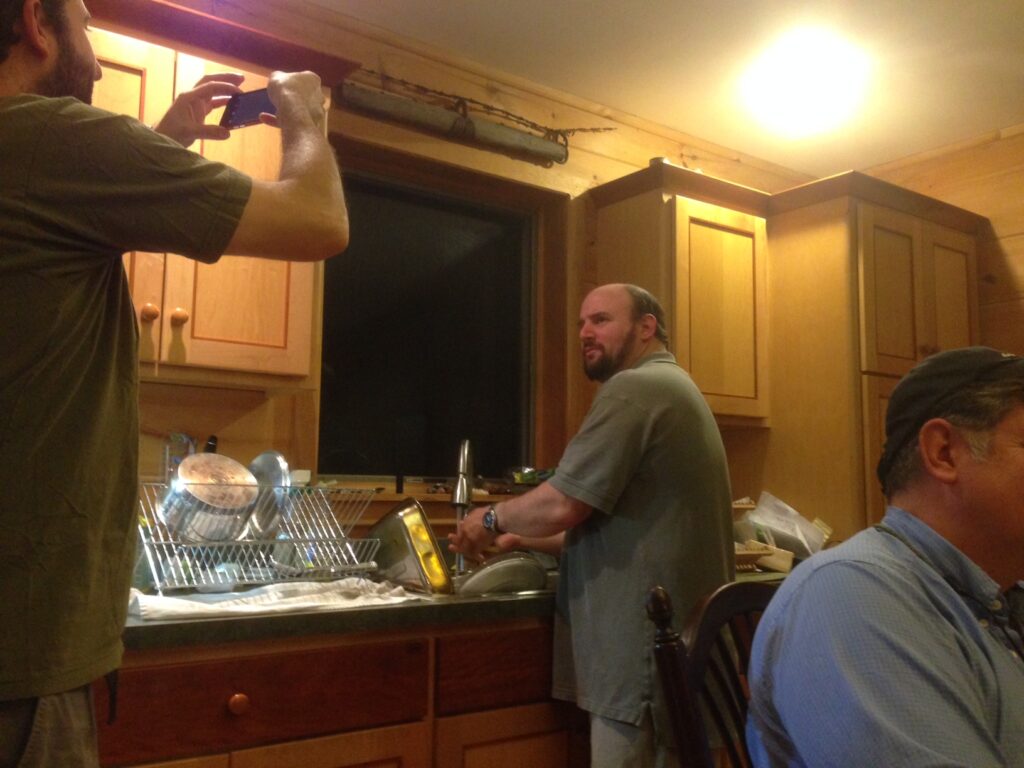
When one of our guys is finally browbeaten into washing dishes after years, it is cause for “Notify the media” acts like taking his unhappy picture. This is back in 2015. He still has to be browbeaten into washing the damned dishes

Lycoming County is the boot-looking shape in the northcentral area. Its northwestern corner is where we hunt. The darkest township there demonstrates the importance of organized hunting drives. A bunch of large hunting clubs are located in this area, and their members put on highly coordinated, obviously successful drives.
Good luck, bear hunters!
Bear rifle season is here in Pennsylvania, starting tomorrow morning, and in many rural places bear hunting has displaced deer hunting as the primary outdoor recreational activity.
Pennsylvania’a bear population is at an all-time (modern times) high, as demonstrated at least in my own small world by the large black bear that showed up a block from my Harrisburg City home last year. Or the other bear that showed up on the same street, but ten blocks closer to the down-town area, a few months later. When bears are showing up in major cities, you know their regular rural habitat is filled up, and the younger generations are looking for new homes.
So good luck to Pennsylvania’s bear hunters tomorrow through next Wednesday. Our own crew is half of the usual number, due to some guys fearing the CCP virus, and some others having health emergencies at home that prevent them from traveling. Normally we field guys from five states across the East Coast, and at one time, all the way from California. Last year we had a guy from England. Usually the cabin is packed and noisy, and this year it will be more subdued. Nonetheless, despite the challenges this year, we will still field a hunting crew. Some will be out tomorrow, some out Sunday, and some out the rest of the week.
Here in the hills, we have not seen bear sign for a long time, which is surprising. Our township here usually produces one of the highest bear harvests in the entire state. We shall see what happens, however, as hunters enter the woods and begin to push animals around. In places where no bears have been seen all year, there could well be a bunch running through.
Good luck to those who are hunting alone, with family, or with their usual chums. For me, this time together just cannot be missed. It comes just once a year, and is gone so quickly that you almost can’t believe it was here to begin with.
Be safe and have fun!
